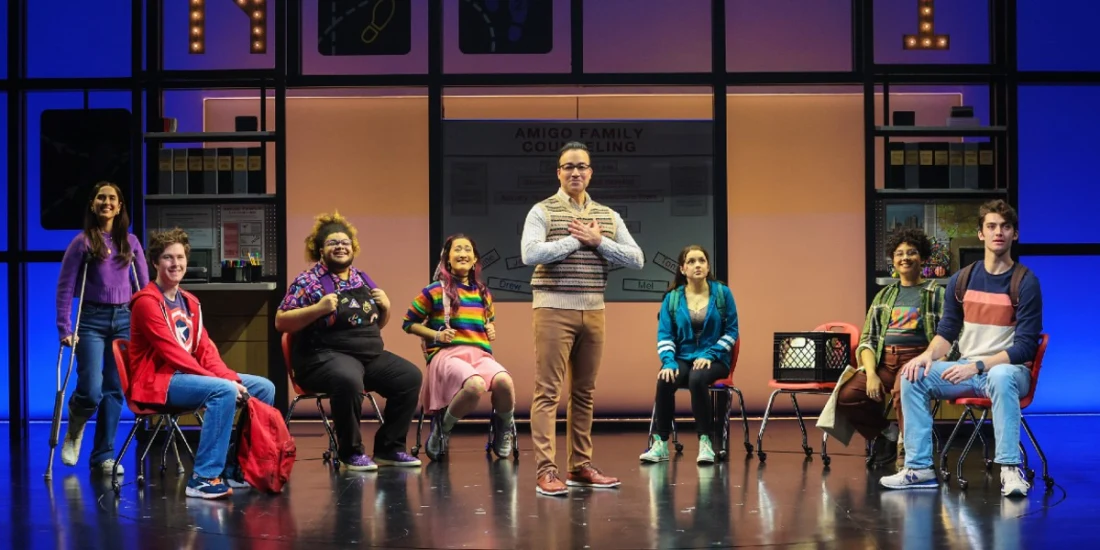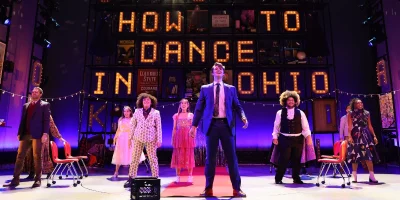
Guide to 'How to Dance in Ohio' on stage and screen
Learn how the Broadway musical about autistic, young adults reflects and differs from its source material: Alexandra Shiva's Peabody Award-winning documentary.
The new Broadway musical How to Dance in Ohio tells the story of seven young adults with autism preparing for their first spring prom. That’s a challenging proposition for anyone, and it goes double for individuals who struggle to socialize, as they relate to the world differently than neurotypical people.
Filmmaker Alexandra Shiva knows that. Her award-winning 2015 documentary How to Dance in Ohio is the basis of the stage show, and the musical was a one-of-a-kind production before anyone sang a note. That owes to the fact that the seven main actors, like their characters, all have autism. That adds a layer of authenticity, even though autism looks different for everyone who has it. “If you know one person with autism, you know one person with autism,” one character says in the show’s prologue.
Therefore, the performers experience and portray autism differently than their documentary counterparts. Of course, as with every screen-to-stage adaptation, what’s on stage at the Belasco Theatre reflects and diverges from its cinematic source in many other ways, too.
Learn more about How to Dance in Ohio, including how the documentary first came to be, facts about its subjects, and how the film and musical differ.
The history of the How to Dance in Ohio documentary and musical
The story at the core of the film and musical is about connections. It’s fitting that Shiva had a personal tie to autism, a neurodevelopmental condition that impacts social interaction and communication skills in a constellation of ways.
One of Shiva’s friends has a daughter the director has known since she was 4. “She’s on the autism spectrum and happens to be nonverbal,” Shiva told HBO, which released the documentary. That’s not the case with any of the characters in the documentary or on stage.
Shiva was curious about what happens to teens and young adults on the spectrum as they grew up and, in many cases, out of parental or governmental support. She wondered about where they’d work and live – and set out to explore those questions.
Through an acquaintance, Shiva met Dr. Emilio Amigo, a clinical psychologist who runs a family counseling center in Columbus, Ohio. At the time, Amigo was planning a formal dance as part of a social skills program at the group counseling center. That was Shiva’s "aha" moment.
“That’s where it really crystallized,” she told HBO. “I thought that was the perfect way to tell the story because it’s so relatable. Everyone knows what it’s like to be scared of a dance or a date.”
The How to Dance in Ohio film premiered at the Sundance Film Festival in January 2015. It was released that October and won a Peabody Award in 2016.
In 2017, Shiva approved two Ohio natives — composer Jacob Yandura, who has an autistic sister, and bookwriter/lyricist Rebekah Greer Melocik, who has Tourette syndrome — to musicalize her film. The project then came to the attention of legendary Broadway producer and director Harold Prince, who developed Ohio and guided workshops until his death in 2019. Director Sammi Cannold, whose brother is autistic, then took over.

Real people featured in How to Dance in Ohio
The documentary focuses on three young women with autism who face fears and worries as they get ready for the dance. Sixteen-year-old Marideth prefers researching facts on her computer alone to being with her parents and sister. “I’m not a very social person,” she tells the filmmaker.
Jessica, 22, lives with her parents and works at a bakery, where she struggles at times with coworkers. Nineteen-year-old Caroline, Jessica's best friend, is a college student who met her boyfriend at the counseling center.
The documentary features other clients with autism, too, including Remy, who’s deep into cosplay; Tommy, who nerds out on comic books; and Drew, who keeps a low profile in the movie. These people only appear briefly in the documentary. But in one of the biggest departures from the film, Remy, Tommy, Drew, and a new character named Mel get equal billing to Marideth, Jessica, and Caroline on stage.
Differences between the How to Dance in Ohio film and musical
In the move from stage to screen, new characters and plots got added to How to Dance in Ohio, while some of the film's existing elements took on a larger life.
The principal cast of characters is larger in the musical.
While the documentary focuses on three women, the musical centers on seven young adults of various genders. The role of Drew is particularly larger on stage. His college plans – whether he'll attend school in Ohio or Michigan – are now a major subplot that impacts him, his parents, and Dr. Amigo. (The stage story seems to be fueled by an Ohio State T-shirt seen in the movie.)
Additionally, Mel rounds out the main cast as a composite character who isn’t in the movie. Some of Jessica's job challenges are instead Mel's on stage. Marideth’s mom and sister, meanwhile, are no longer in the picture – it’s just her and her dad, apparently for the sake of theatrical stakes.
The Amigos have expanded roles.
“Parts have been embellished for dramatic purposes,” an actor tells us in a prologue to How to Dance in Ohio on Broadway. That also includes the therapist. Dr. Amigo’s role, on the sidelines on screen, is front and center in the musical. The same is true of his daughter, Ashley, who works at the center. (On screen, it's not immediately apparent that Ashley is Dr. Amigo's daughter, whereas it's introduced at the start of the musical.)
Unlike the doc, the musical dives into Dr. Amigo’s dating life. Ashley’s questions about college – unexplored in the film but used on stage to mirror Drew's struggles – also get a fair share of stage time.
The musical adds a subplot about journalism and ableism.
Two characters unique to the musical are reporters keen on covering the spring formal. Dr. Amigo asks them not to write that his clients “suffer from autism,” but one of them, a blogger, uses that precise language and other ableist cliches.
The story sets off a disastrous chain of events and alienates the therapist from his clients and others he cares about — serving as an educational moment for the audience on inclusive language and the importance of centering disabled people in their own stories.
The doc and musical lead to an upbeat finale.
The climax of both the film and the musical revolves around the highly anticipated dance. Each version captures the joy and anxiety the clients experience as they take to the dance floor. In the end, How to Dance in Ohio is a striking reminder: Going to prom, like making a movie or a musical, is a complex, step-by-step process.
Photo credit: The cast of How to Dance in Ohio on Broadway. (Photo by Curtis Brown)
Frequently asked questions
What is How to Dance in Ohio on Broadway about?
Dance and sing for the musical adaptation of Alexandra Shiva's Peabody Award-winning documentary of the same name. Go along with seven autistic adults as they prepare for a spring formal dance — and in the process, find new courage and confidence as they change up their everyday lives.
Where is How to Dance in Ohio on Broadway playing?
How to Dance in Ohio on Broadway is playing at Belasco Theatre. The theatre is located at 111 West 44th Street, New York, 10036.
How long is How to Dance in Ohio on Broadway?
The running time of How to Dance in Ohio on Broadway is 2h 20m (Incl. 15m Intermission)
What's the age requirement for How to Dance in Ohio on Broadway?
The recommended age for How to Dance in Ohio on Broadway is Recommended for 6+. Children under the age of 4 are not permitted in the theatre..
How do you book tickets for How to Dance in Ohio on Broadway?
Book tickets for How to Dance in Ohio on Broadway on New York Theatre Guide.
What are the songs in How to Dance in Ohio?
Rebekah Greer Melocik and Jacob Yandura's original score for How to Dance in Ohio includes songs titled "Building Momentum," "So Much in Common," "Under Control," and "Getting Ready for the Dance."
Who wrote How to Dance in Ohio?
How to Dance in Ohio is written by Rebekah Greer Melocik (book and lyrics) and Jacob Yandura (music). They adapted the show from Alexandra Shiva's award-winning documentary of the same name, and Melocik and Yandura are making their Broadway debuts.
Who directed How to Dance in Ohio on Broadway?
Sammi Cannold directs How to Dance in Ohio on Broadway. She's directed acclaimed shows at renowned venues like Radio City Music Hall, Lincoln Center, and the Kennedy Center, and she now makes her Broadway debut. Alexandra Shiva directed the original documentary the musical is based on.
Is How to Dance in Ohio appropriate for kids?
How to Dance in Ohio is suitable for children 6 and older. Please note that children 4 and younger are not permitted in Broadway theatres.
Is How to Dance in Ohio good?
How to Dance in Ohio is an original new musical that thoughtfully explores the lives and coming of age of autistic people. The show is uplifting, inspiring, and celebratory.
Originally published on


